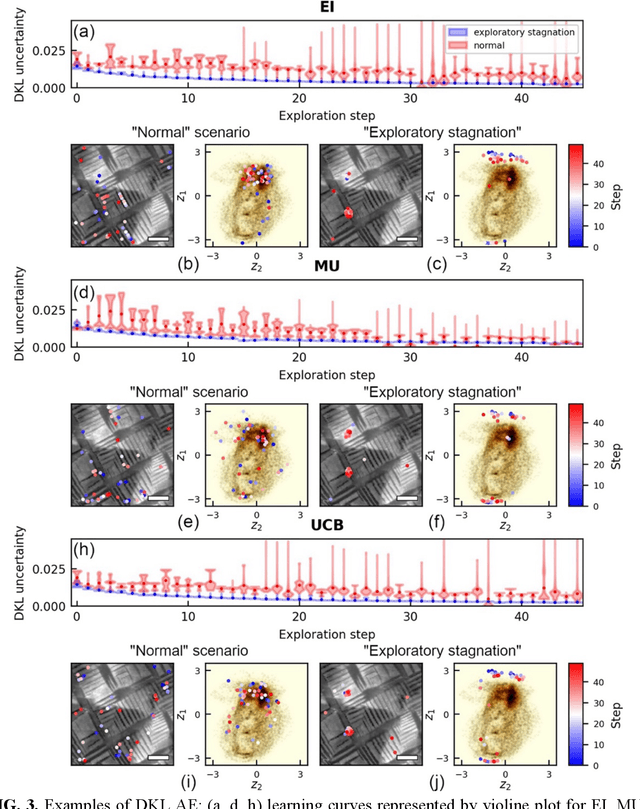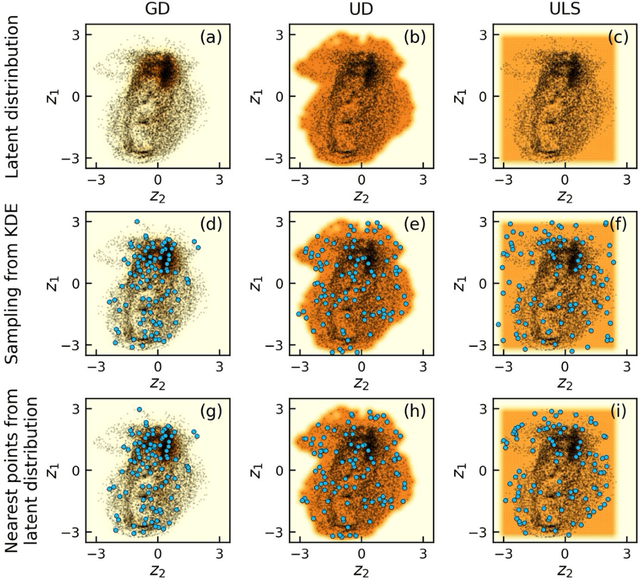Boris N. Slautin
Integrating Predictive and Generative Capabilities by Latent Space Design via the DKL-VAE Model
Mar 04, 2025Abstract:We introduce a Deep Kernel Learning Variational Autoencoder (VAE-DKL) framework that integrates the generative power of a Variational Autoencoder (VAE) with the predictive nature of Deep Kernel Learning (DKL). The VAE learns a latent representation of high-dimensional data, enabling the generation of novel structures, while DKL refines this latent space by structuring it in alignment with target properties through Gaussian Process (GP) regression. This approach preserves the generative capabilities of the VAE while enhancing its latent space for GP-based property prediction. We evaluate the framework on two datasets: a structured card dataset with predefined variational factors and the QM9 molecular dataset, where enthalpy serves as the target function for optimization. The model demonstrates high-precision property prediction and enables the generation of novel out-of-training subset structures with desired characteristics. The VAE-DKL framework offers a promising approach for high-throughput material discovery and molecular design, balancing structured latent space organization with generative flexibility.
Rewards-based image analysis in microscopy
Feb 23, 2025Abstract:Analyzing imaging and hyperspectral data is crucial across scientific fields, including biology, medicine, chemistry, and physics. The primary goal is to transform high-resolution or high-dimensional data into an interpretable format to generate actionable insights, aiding decision-making and advancing knowledge. Currently, this task relies on complex, human-designed workflows comprising iterative steps such as denoising, spatial sampling, keypoint detection, feature generation, clustering, dimensionality reduction, and physics-based deconvolutions. The introduction of machine learning over the past decade has accelerated tasks like image segmentation and object detection via supervised learning, and dimensionality reduction via unsupervised methods. However, both classical and NN-based approaches still require human input, whether for hyperparameter tuning, data labeling, or both. The growing use of automated imaging tools, from atomically resolved imaging to biological applications, demands unsupervised methods that optimize data representation for human decision-making or autonomous experimentation. Here, we discuss advances in reward-based workflows, which adopt expert decision-making principles and demonstrate strong transfer learning across diverse tasks. We represent image analysis as a decision-making process over possible operations and identify desiderata and their mappings to classical decision-making frameworks. Reward-driven workflows enable a shift from supervised, black-box models sensitive to distribution shifts to explainable, unsupervised, and robust optimization in image analysis. They can function as wrappers over classical and DCNN-based methods, making them applicable to both unsupervised and supervised workflows (e.g., classification, regression for structure-property mapping) across imaging and hyperspectral data.
Measurements with Noise: Bayesian Optimization for Co-optimizing Noise and Property Discovery in Automated Experiments
Oct 03, 2024Abstract:We have developed a Bayesian optimization (BO) workflow that integrates intra-step noise optimization into automated experimental cycles. Traditional BO approaches in automated experiments focus on optimizing experimental trajectories but often overlook the impact of measurement noise on data quality and cost. Our proposed framework simultaneously optimizes both the target property and the associated measurement noise by introducing time as an additional input parameter, thereby balancing the signal-to-noise ratio and experimental duration. Two approaches are explored: a reward-driven noise optimization and a double-optimization acquisition function, both enhancing the efficiency of automated workflows by considering noise and cost within the optimization process. We validate our method through simulations and real-world experiments using Piezoresponse Force Microscopy (PFM), demonstrating the successful optimization of measurement duration and property exploration. Our approach offers a scalable solution for optimizing multiple variables in automated experimental workflows, improving data quality, and reducing resource expenditure in materials science and beyond.
Bayesian Co-navigation: Dynamic Designing of the Materials Digital Twins via Active Learning
Apr 19, 2024



Abstract:Scientific advancement is universally based on the dynamic interplay between theoretical insights, modelling, and experimental discoveries. However, this feedback loop is often slow, including delayed community interactions and the gradual integration of experimental data into theoretical frameworks. This challenge is particularly exacerbated in domains dealing with high-dimensional object spaces, such as molecules and complex microstructures. Hence, the integration of theory within automated and autonomous experimental setups, or theory in the loop automated experiment, is emerging as a crucial objective for accelerating scientific research. The critical aspect is not only to use theory but also on-the-fly theory updates during the experiment. Here, we introduce a method for integrating theory into the loop through Bayesian co-navigation of theoretical model space and experimentation. Our approach leverages the concurrent development of surrogate models for both simulation and experimental domains at the rates determined by latencies and costs of experiments and computation, alongside the adjustment of control parameters within theoretical models to minimize epistemic uncertainty over the experimental object spaces. This methodology facilitates the creation of digital twins of material structures, encompassing both the surrogate model of behavior that includes the correlative part and the theoretical model itself. While demonstrated here within the context of functional responses in ferroelectric materials, our approach holds promise for broader applications, the exploration of optical properties in nanoclusters, microstructure-dependent properties in complex materials, and properties of molecular systems. The analysis code that supports the funding is publicly available at https://github.com/Slautin/2024_Co-navigation/tree/main
Multimodal Co-orchestration for Exploring Structure-Property Relationships in Combinatorial Libraries via Multi-Task Bayesian Optimization
Feb 03, 2024Abstract:The rapid growth of automated and autonomous instrumentations brings forth an opportunity for the co-orchestration of multimodal tools, equipped with multiple sequential detection methods, or several characterization tools to explore identical samples. This can be exemplified by the combinatorial libraries that can be explored in multiple locations by multiple tools simultaneously, or downstream characterization in automated synthesis systems. In the co-orchestration approaches, information gained in one modality should accelerate the discovery of other modalities. Correspondingly, the orchestrating agent should select the measurement modality based on the anticipated knowledge gain and measurement cost. Here, we propose and implement a co-orchestration approach for conducting measurements with complex observables such as spectra or images. The method relies on combining dimensionality reduction by variational autoencoders with representation learning for control over the latent space structure, and integrated into iterative workflow via multi-task Gaussian Processes (GP). This approach further allows for the native incorporation of the system's physics via a probabilistic model as a mean function of the GP. We illustrated this method for different modalities of piezoresponse force microscopy and micro-Raman on combinatorial $Sm-BiFeO_3$ library. However, the proposed framework is general and can be extended to multiple measurement modalities and arbitrary dimensionality of measured signals. The analysis code that supports the funding is publicly available at https://github.com/Slautin/2024_Co-orchestration.
Unraveling the Impact of Initial Choices and In-Loop Interventions on Learning Dynamics in Autonomous Scanning Probe Microscopy
Jan 30, 2024



Abstract:The current focus in Autonomous Experimentation (AE) is on developing robust workflows to conduct the AE effectively. This entails the need for well-defined approaches to guide the AE process, including strategies for hyperparameter tuning and high-level human interventions within the workflow loop. This paper presents a comprehensive analysis of the influence of initial experimental conditions and in-loop interventions on the learning dynamics of Deep Kernel Learning (DKL) within the realm of AE in Scanning Probe Microscopy. We explore the concept of 'seed effect', where the initial experiment setup has a substantial impact on the subsequent learning trajectory. Additionally, we introduce an approach of the seed point interventions in AE allowing the operator to influence the exploration process. Using a dataset from Piezoresponse Force Microscopy (PFM) on PbTiO3 thin films, we illustrate the impact of the 'seed effect' and in-loop seed interventions on the effectiveness of DKL in predicting material properties. The study highlights the importance of initial choices and adaptive interventions in optimizing learning rates and enhancing the efficiency of automated material characterization. This work offers valuable insights into designing more robust and effective AE workflows in microscopy with potential applications across various characterization techniques. The analysis code that supports the funding is publicly available at https://github.com/Slautin/2024_Seed_effect_DKL_BO.
 Add to Chrome
Add to Chrome Add to Firefox
Add to Firefox Add to Edge
Add to Edge